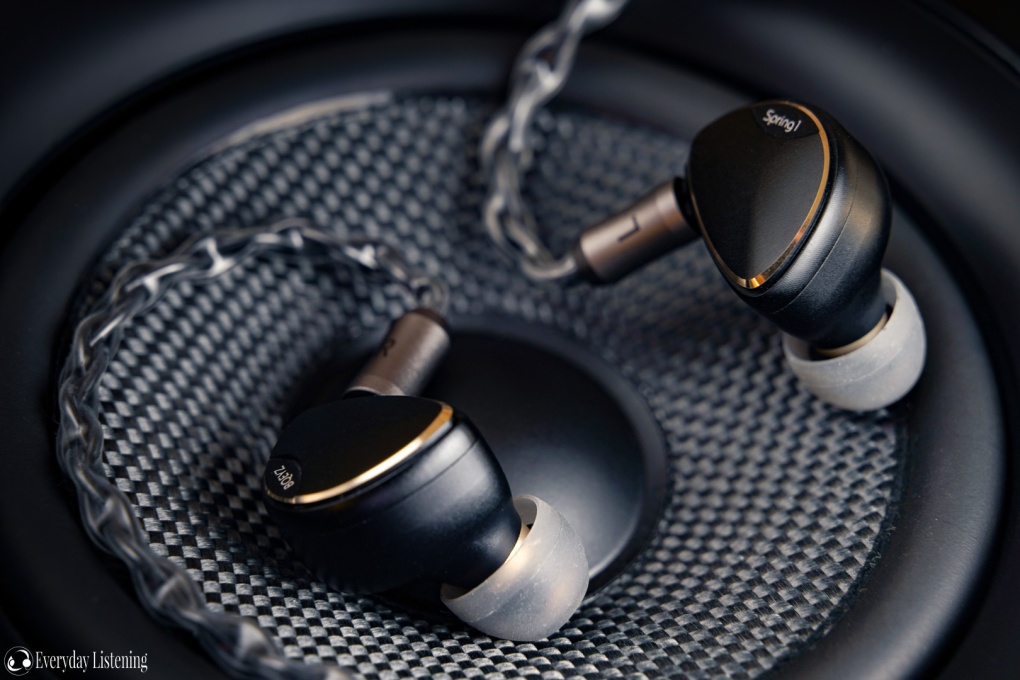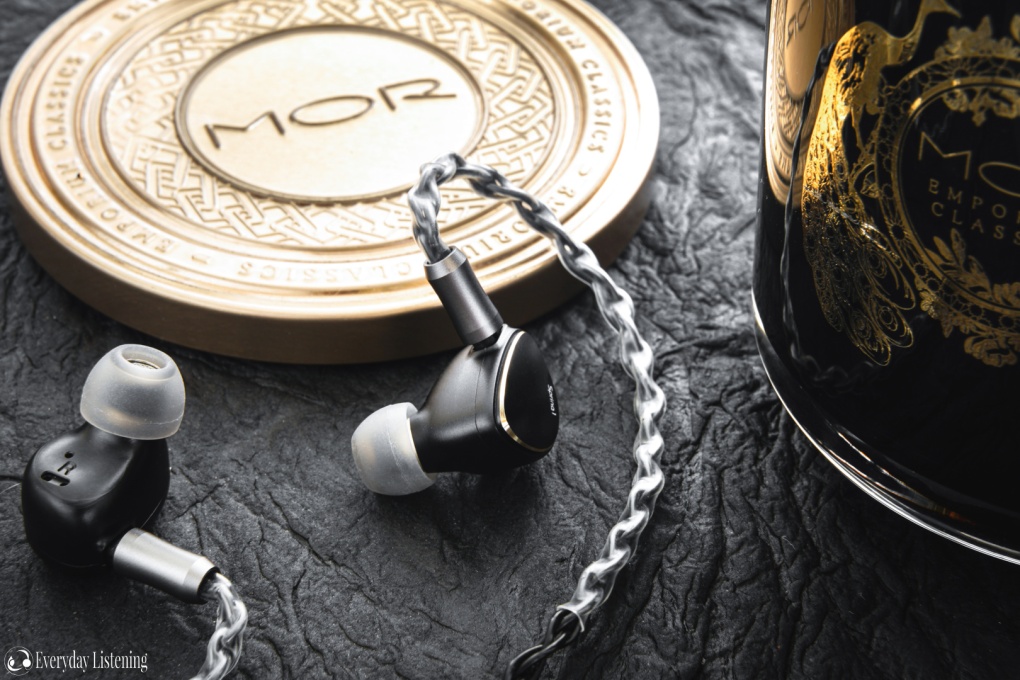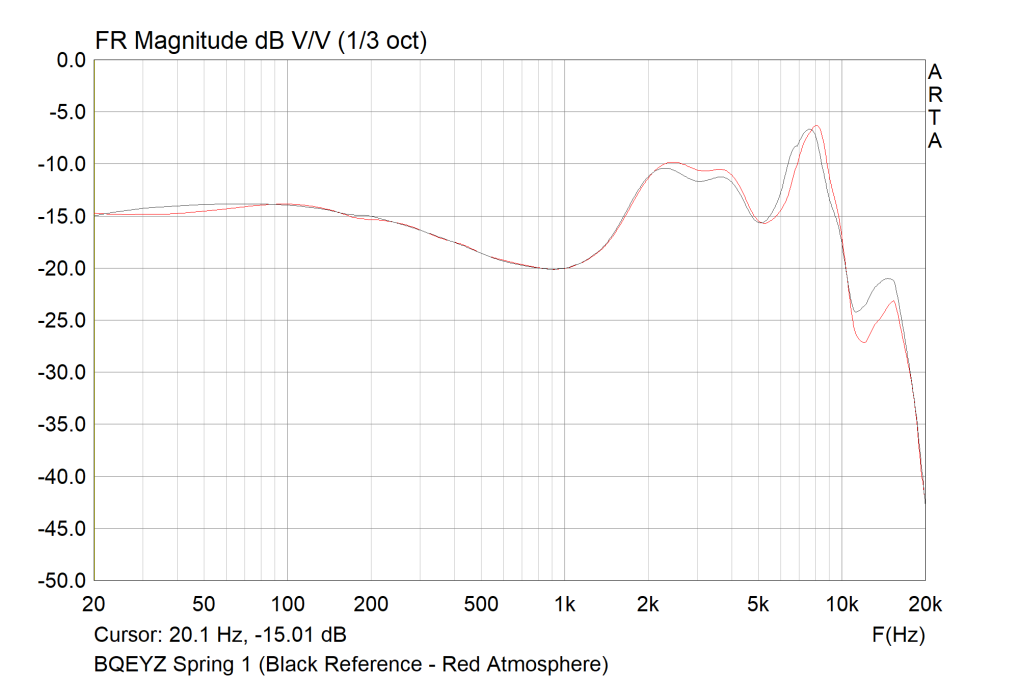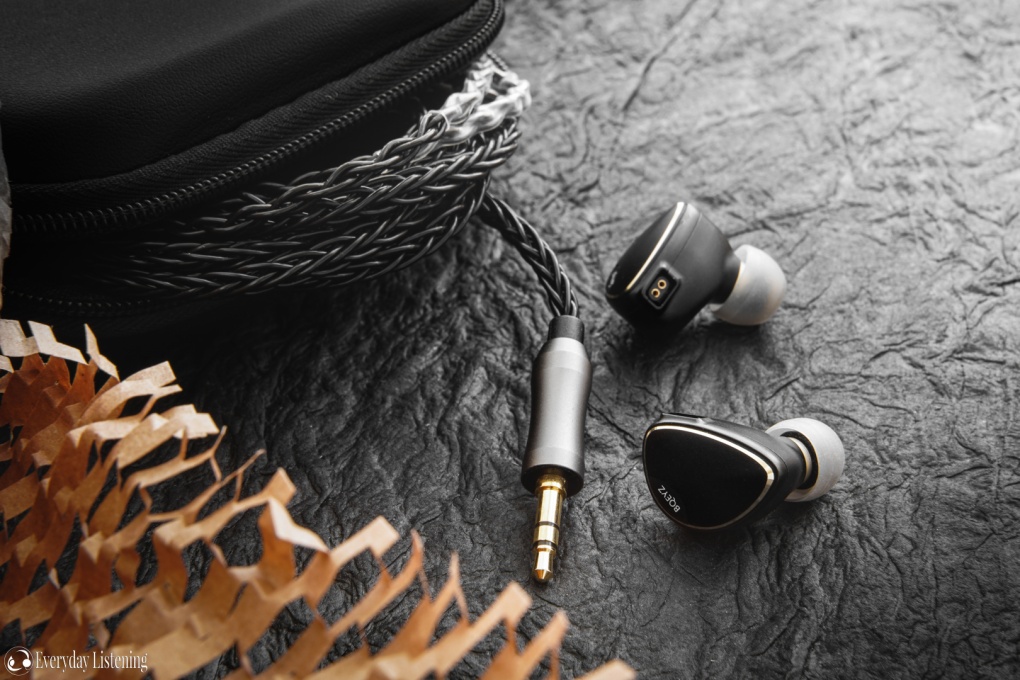BQEYZ Spring 1 Review – Split

Pros –
Excellent bass quality, Clean treble transients, Engaging yet balanced signature, Excellent value tribrid setup
Cons –
Mediocre noise isolation, Slightly thin midrange, Limited fit depth
Verdict –
The Spring 1 excels in its careful modulation of engagement and smoothness to deliver strong tri-frequency contrast while upholding a tasteful tone and midrange voicing.
Introduction –
Though BQEYZ doesn’t quite roll off the tongue, the company is another ChiFi hit who I somewhat remiss not involving myself with sooner. The company is new, but not at all inexperienced and similar to other now prominent players such as Kinera, they’ve been working as an earphone and headphone OEM for over 20-years. The Spring 1 showcases their experience and prowess, possessing a peculiar tribrid driver setup not dissimilar to much more expensive IEMs. Alongside a custom 13mm dynamic driver, the BQEYZ has a custom-tuned balanced armature driver handling mids and highs with an additional 7-layer piezoelectric super tweeter. No sir, this is no generic earphone and, at a modest $139 USD, it’s no surprise that it’s become such a staple. You can read more about the BQEYZ and treat yourself to one on BQEYZ’s Aliexpress page and on HiFiGO.
Disclaimer –
I would like to thank Elle from BQEYZ very much for her quick communication and for providing me with the Spring 1 for the purpose of review. All words are my own and there is no monetary incentive for a positive review. Despite receiving the earphones free of cost, I will attempt to be as objective as possible in my evaluation.
Specs –
Driver unit: 1 Coaxial dynamic driver+7 Layers piezoelectric+1 Balanced armature
Impedance: 43Ω
Sensitivity: 108dB
Frequency: 7-40KHz
Cable Length: 1.2m
Pin Type: 0.78mm 2 Pin
Plug Type: 3.5mm jack adapter
Cable Length: 120cm
Whether with Mic: No
The Pitch –
Custom-tuned drivers
With their manufacturing processes developed over their 20 years of experience, BQEYZ is able to custom tune and manufacture all of their drivers in-house. This grants them great control over both the tuning and quality of the sound in addition to minimising the cost of more sophisticated driver setups as observed on the Spring 1.
Ceramic super-tweeter
Those watching the high-end IEM space might have seen Sonion’s new EST drivers pop up in a few models to much elation and critique. Electrostatic drivers provide much lower distortion and greater high-frequency extension than BA drivers, however, as they can only be driven at high-voltages, they require a transformer making them highly inefficient. This is compounded upon by their inability to reproduce low frequencies, necessitating the addition of dynamic or balanced armature drivers with much higher sensitivity. In addition to their exorbitant cost, you can already see just how difficult the tuning process becomes.

Source: BQEYZ Aliexpress product page
Ceramic tweeters are functionally similar to EST drivers but substitute a charged mylar film with ceramic. They are considerably cheaper and easier to pair with other driver types while bringing similar characteristics with regards to extension and distortion, if to a lesser extent. The Piezo driver has its own problem, a ceramic resonance at 10KHz which made first-generation ceramic earphones sound thin and sharp. By implementing a multi-layer design and optimising the sound cavity, a few later designs from high-end manufacturers like Noble and Hyla successfully shifted this resonance into more palatable ranges. Though the ceramic implementation is not nearly as refined, the Spring 1 implements the same design and takes cost-efficiency one step further with a unibody dynamic + ceramic design that represents the same key qualities at a significantly lower price.
Accessories –

The Spring 1 has a pleasing unboxing experience and has a comprehensive accessory set. Inside the box, users will be greeted by a leatherette zippered carrying case, the earphones themselves alongside a silver-plated removable cable. There’s a lovely metal tip selector that sits comfortably within the case with 2 sets of tips featuring reference and atmospheric sound profiles. A pair of foam tips are also included to bolster isolation.
Design –
I was impressed to hear that BQEYZ have their own CNC workshop that specialises in IEM production. It should then come as no surprise that the Spring 1 has an entirely metal enclosure. Though the design is simple, the finish is on par with a pricier model. Its seams are imperceptible by touch while edges are rounded and perfect. The black model has gorgeous dark gold accents that complement their shape and form. They are of quite a unique shape; however, they are reasonably sized and ergonomically contoured.

The cable utilises 0.78mm 2-pin connectors. It’s a beefy 8-core unit with silver-plated conductors and smooth plastic insulation. The cable is supple with zero memory, coiling easily for storage. It produces minimal microphonic noise in culmination with an over-ear fit and feels very beefy and built to last. Gunmetal BQEYZ inscribed terminations provide a premium impression alongside the case-friendly 3.5mm plug and ample strain relief. The cable has pre-moulded ear guides that weren’t perfectly suited to my ear shape but provided comfortable wear, nonetheless.
Fit & Isolation –

As the housings are reasonably compact, I didn’t find them to contact much of the outer ear nor form hotspots over extended listening. The nozzles are on the longer side and angled to position them neutrally, aiding wearing comfort. Meanwhile, the crescent-housings follow the natural curves of the outer ear, providing good stability if not the same locked-in sensation of faux custom earphones. Numerous vents are clearly visible on the inner face of the earphones, making them quite open and without vacuum-like seal. As they’re on the inner face, wind noise isn’t prevalent when wearing the earphones outdoors, however, isolation is only mediocre which may limit appeal for commute yet alone travel. Due to the large nozzles, fit depth is on the shallower side and I was unable to increase this by sizing down tips.
Sound –

Testing Methodology: Arta via IEC 711 coupler to Startech external sound card. Note that 7-8KHz peaks are artefacts of my measurement setup. Measurements besides channel balance are volume matched at 1K.
Tonality –
The Spring 1 has what I would describe as a high-end IEM tuning, that being W-shaped, vocal-forward but boosted at the extremities. This is not to say that it performs like a high-end IEM, but it does provide an engaging listen with great contrast while maintaining tri-frequency balance. There’s really solid sub-bass body alongside enhanced mid and upper-bass warmth mitigated by a clean vocal push through the centre midrange. Lower-treble has been attenuated in order to combat sibilance, sharpness and thinness before a reasonable middle-treble peak as I’ve been told, is quite a common resonant point for ceramic drivers. The unique combination of drivers certainly does produce similarly intriguing qualities in real-world listening. This earphone isn’t linear and doesn’t trace any conventional curve but remains a fun and insightful listen.
Tip Selection –
The Spring 1 comes with a delightful metal tip selector with three tuning choices, reference for human voices, atmosphere for bass and foam for max isolation. In listening, I found the reference tips most desirable to my ear, both of the options from BQEYZ and third party. They provided the most balanced sound while the atmosphere tips provided a more bass focussed sound with even thinner treble and more laid-back vocals. Take my measurements above with a grain of salt, in reality, the tips also affect the fit depth and seal which can have a profound impact on the sound perceived by the listener. The foam tips were an acceptable compromise but overly attenuated the highs for my liking. The following comments will be using the reference tips.
Bass –
Colour me impressed, if you’re looking for power, depth and definition, the low end on the Spring 1 delivers – it’s clear this isn’t a generic dynamic driver implantation and the company has considered the acoustics around it. The low-end is on the more diffuse over coherent side due to a notable sub-bass focus and comparatively reduced mid-bass body. Regardless, this is for good reason as sub-bass has terrific extension, tightness and pressure, delivering visceral slam and defined rumble. Meanwhile, mid and upper-bass are both moderately enhanced just to a lesser degree, and demonstrate good linearity, producing a low-end with thick, bold notes while avoiding excessive warmth or tubbiness.
Driver quality is a high point for the Spring 1, with excellent driver control, keen attack and natural decay providing a handsome balance between pace and dynamics. The earphone’s driver control, in particular, goes far to rein in its bold notes, minimising the smearing of fine details and upholding as much separation as one would hope for given this level of fullness. This isn’t a hyper-fast BA low-end nor a perfectly linear and natural one, and it doesn’t retrieve detail as such with heavier and slightly more lingering notes. The Spring 1 rather delivers a powerful, rumbling bass with good technical ability and great dynamics for engagement over accuracy.
Mids –
In accordance with their W-shaped tuning, vocals are clean, clear and slightly smooth in presentation. They hold precedence over instruments within the midrange due to a lower-midrange dip that mitigates bass spill followed by wideband centre midrange emphasis. As there is no upper-midrange bias, vocals are brought forward but retain a reasonably natural tone. Instead, emphasis sustains linearly from 2KHz all the way through to 4KHz. The midrange, therefore, isn’t especially dense nor is it full-bodied, but provides excellent vocal extension in addition to high clarity while sibilance, thinness and sharpness are mitigated by a sharp trough in the lower-treble.

Vocals are, therefore, smoothly articulated with ample body derived from the midrange itself and a hint of euphonic warmth permeating from the upper-bass. Though a slightly more linear transition into the midrange would have yielded a more accurate timbre and note body, these traits work well in harmony; with bolstered vocal body and warmth counterbalancing enhanced vocal size and intimacy. Again, timbre isn’t nearly perfect and note resolution leaves to be desired. However, there are no immediate flaws in its presentation which cannot be said for a lot of budget hybrids. Simply put, the Spring 1’s midrange is well-balanced between male and female in addition to being layered, defined and natural in tone.
Highs –
Though we have a very small number of ceramic tweeter earphones, they all have a distinct sound, being emphasized around the middle-treble region, and providing thin but immaculately clean transients. Though the lowest cost-implementation I’ve heard, many of the same qualities can be observed here. Actually, I was relieved to see a laid-back lower-treble which may smooth off attack but also takes the sharpness and sibilance out of its presentation. To redeem clarity and crispness, there’s a modest peak around 7-8KHz that bolsters both air and detail presence. The background remains fairly clean nonetheless, as quantity diminishes quickly after. As this is a narrow peak, note body is thin though instruments such as cymbals retain nice texture if with somewhat truncated shimmer, while lacking hard-edged percussion due to the earphone’s lower-treble tuning.
What the ceramic driver provides here is immense cleanliness and agility within the foreground which translates to a focussed and resolving presentation. There’s also a touch of warmth in the treble which, in conjunction with excellent detail retrieval, makes this earphone a great choice for acoustic. They also suit rock where their clean transients control any brittle or splashy character. There’s a pleasing amount of air but little upper-treble sparkle and extension so the immaculate and resolving character of high-end ceramic IEMs is not present here. Nonetheless, micro-details are impressively abundant and the background is reasonably well-defined. Though not the most aggressive earphone, the ceramic driver retains a crisp, well-detailed image despite their smoother attack at the expense of distinctly thin note body.
Soundstage –
The Spring 1 provides a reasonably large stage that extends just beyond the head in terms of width and, despite its vocal presentation, is able to project pleasing depth too. As such, it presents a nicely rounded sound. Imaging is sharp if not perfectly coherent or accurate to my ears. Quick, clean treble transients permit sharp directional cues and strong directionality if not perfect precision to panning and transitions. Meanwhile, vocals maintain a strong centre image providing defined and distinct layering. The earphones possess strong separation on behalf of their controlled bass and W-shaped signature that heightens the distinction between each core frequency band in addition to high driver control and note body that generally errs on the slightly thinner side of neutral.
Driveability –
With a higher 43ohm impedance paired with a similarly high 108dB sensitivity, the Spring 1 is reasonably efficient in addition to being impressively agnostic to output impedance. In fact, comparing between my desktop JDS Atom setup with the 10-ohm Hiby R6 yielded very minimal differences to signature beyond the tone of the sources themselves. The Hiby has a touch warmer and smoother up top most notably due to a small difference within the upper-midrange; the Atom being a touch more forward, the Hiby more laid-back. The Spring 1 scales well with a bit of power, especially within the bass where control is noticeably improved alongside associated qualities of definition, detail retrieval and separation. Still, the Spring 1 is very forgiving of the source and a great choice for smartphone listeners due to its efficiency and stable signature.
Comparisons –

Moondrop Starfield ($109): The Moondrop is a legend in its price class, I haven’t seen such unanimous praise for a long time. By comparison, it is more linear and less dynamic with a generally smoother and more coherent voicing. Its low end lacks the same pressure but extends similarly well. The Spring 1 has more bass presence, especially sub-bass, and higher driver control with a lot more bass note definition and separation. The midrange is forward on both, more upper-midrange biased on the Starfield but also denser and more linear in transition from the bass. The Starfield has a slightly more natural voicing and a more accurate timbre as a result, possessing better balance between body, tone and density.
Contrarily, the Spring 1 has more vocal definition but is also less coherent with lower note resolution. The Starfield has a more linear top-end too, the Spring 1 has cleaner transients, more extension and resolution with superior detail retrieval. Meanwhile, the Starfield sounds more natural, its instruments have more body and texture alongside more coherent positioning within its stage. Both have similar soundstage expansion, the Spring 1 has a touch more width and better separation while the Starfield possesses more accurate imaging.
Final Audio E4000 ($140): The E4000 is a more L-shaped earphone with more bass emphasis and a laid-back top-end. The E4000 has more bass quantity overall, it has similar extension but less sub-bass bias, being more linear. As it has more mid and upper-bass presence, it is warmer and slightly fuller where the Spring 1 is cleaner in tone but also less natural sounding. Both have excellent driver control, the Spring 1’s cleaner tuning results in greater separation and definition, it has slightly sharper attack where the E4000 is smoother. The E4000 has more substantial vocals, with greater body and slightly more warmth.
It has similar definition but higher note resolution and better coherence. The E4000 sounds more natural and accurate in timbre while the Spring 1 has better separation and more defined layers. The Spring 1 has a crisper, thinner treble with a cleaner tone and sharper note attack. The E4000 has a warmer treble with a lot more body and greater texture. The E4000 has a darker background while the Spring 1 has better extension with more background detail retrieval and resolution. The E4000 has a slightly larger soundstage with more accurate imaging while the Spring 1 has a lot more separation.
Shozy CP ($170): The CP is another well-balanced offering around this price range, sporting an all BA setup. It has less substantial bass, the Spring 1 has a more quantity and extension, delivering a weightier, fuller presentation. The CP is much quicker decaying with tighter, punchier notes and more definition while the Spring 1 has bolder more naturally decaying notes with greater dynamics. Both have strong vocal presence, the CP is slightly more neutral where the Spring 1 is a touch forward. The CP also transitions more linearly into the midrange, so alongside greater upper-midrange bias, it has more clarity and similar body.
The CP is also a touch warmer from its upper-bass and sounds slightly more natural to my ear. Meanwhile, the Spring 1 has slightly higher vocal definition and separation, I also hear more defined layers especially due to its more resolving top-end. The CP has a small lower treble peak for clarity and energy, it has a crisper and sharper treble. Meanwhile, the Spring 1 is cleaner in its presentation, being less aggressive in the foreground but offering greater extension and slightly better resolution. The Spring 1 has a larger soundstage while the imaging is a bit more stable on the CP.
Hyla CE-5 ($940): Obviously no comparison is to be had regarding price, however, as one of the pioneers of piezoelectric tribrids, I felt it apt. The CE-5 offers slightly less bass quantity with better extension linearity between sub and mid-bass. It has higher driver control with more texture and detail retrieval, the CE-5 has better dynamics and a more natural note presentation. The CE-5 has a more forward midrange with greater upper-midrange bias. Neither are dense actually, the Spring 1 is a bit more natural here while the CE-5 has quite a sharp lower-midrange attenuation that can make it sound a bit thin and dry at times.
The Spring 1 has more body and isn’t quite as forward sounding, both are quite smooth due to lower-treble attenuation. Up top, the CE-5 has a crisper presentation with more aggressive attack. It is brighter overall but also a lot more detailed with higher resolution and stronger extension, even a good amount of sparkle. The Spring 1 has slightly more treble warmth and body, being smoother and more balanced but lacking the same transient cleanliness. The CE-5 provides a larger soundstage, neither have perfectly coherent imaging but the CE-5 has stronger directionality due to its keener treble transients.
Verdict –

To my ears, the hallmark of nailing an outstanding budget earphone is to make the listener forget that they’re listening to a budget earphone, not to convince the listener that they’re listening to a high-end one. In that sense, the market has come far, I’m seeing substantially more natural tonalities and less treble peakiness than before. I also have an ever-increasing repertoire of models where the former comment applies, as seen in my comparisons. The Spring 1 is a curious offering as it treads a fine line down the middle of the two. In terms of technical ability, the Spring 1 will likely fool many listeners, especially with regards to its stringently controlled bass and clean, resolving treble, there’s some proper design going on there. The tuning is also relatively balanced and quite mature if not especially linear or conventional. This earphone, therefore, isn’t for those wanting huge engagement and doesn’t suit those valuing timbre either. Rather, the Spring 1 excels in its careful modulation of both, delivering strong tri-frequency contrast balanced by a tasteful tone and natural midrange voicing.
The Spring 1 is available from on Aliexpress and HiFiGO (International) for $139 USD at the time of writing. I am not affiliated with BQEYZ, Aliexpress or HiFiGO and receive no earnings from purchases through this link.
Track List –
88rising – NIKI Acoustic Sessions
Eagles – Hell Freezes Over
Father John Misty – Pure Comedy
Jeremy Zucker – comethru
Joji – Sanctuary
Lauv – I met you when I was 18
Michael Jackson – XSCAPE
Post Malone – beerbongs & Bentleys
Rich Brian – The Sailor
Sun Rai – Pocket music
The Mamas & Papas – If You Can Believe Your Eyes & Ears
TALA – nothing personal
Yosi Horikawa – Wandering


i mostly enjoy my spring1 but i noticing it misses the airy soundstage of my cheaper grado sr80 that makes me turn my head when i hear a door creaking behind me while watching a movie, is there an affordable iem (sub $150) that offers such open soundstage ? or is it a feature only available on open back over the ear headphones that are very open sounding such as grados ? thanks
LikeLike
Hey Antione,
You won’t find the same experience due the difference in design, but perhaps a similar style of sound can be found.
For Grados, I think the defining trait is the separation. You may enjoy the Final A3000/A4000. Both are brighter sounds, the A4000 especially so. But both also provide very spacious soundstages for an IEM, if not matching an over-ear. However, they have great separation that will feel familiar coming from the Grados.
The A4000 is especially spacious though at the cost of being the less balanced of the two. It is $10 over budget, the A3000 is $10 under. I have written a review of both on my website, hope this helps!
Best.
Ryan.
LikeLike